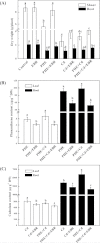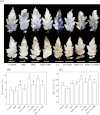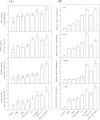Role of brassinosteroids in alleviation of phenanthrene-cadmium co-contamination-induced photosynthetic inhibition and oxidative stress in tomato
- PMID: 23201830
- PMCID: PMC3528031
- DOI: 10.1093/jxb/ers323
Role of brassinosteroids in alleviation of phenanthrene-cadmium co-contamination-induced photosynthetic inhibition and oxidative stress in tomato
Abstract
Heavy metal pollution often occurs together with organic contaminants. Brassinosteroids (BRs) induce plant tolerance to several abiotic stresses, including phenanthrene (PHE) and cadmium (Cd) stress. However, the role of BRs in PHE+Cd co-contamination-induced stress amelioration is unknown. Here, the interactive effects of PHE, Cd, and 24-epibrassinolide (EBR; a biologically active BR) were investigated in tomato plants. The application of Cd (100 µM) alone was more phytotoxic than PHE applied alone (100 µM); however, their combined application resulted in slightly improved photosynthetic activity and pigment content compared with Cd alone after a 40 d exposure. Accumulation of reactive oxygen species and membrane lipid peroxidation were induced by PHE and/or Cd; however, the differences in effect were insignificant between Cd and PHE+Cd. The foliar application of EBR (0.1 µM) to PHE- and/or Cd-stressed plants alleviated photosynthetic inhibition and oxidative stress by causing enhancement of the activity of the enzymes and related transcript levels of the antioxidant system, secondary metabolism, and the xenobiotic detoxification system. Additionally, PHE and/or Cd residues were significantly decreased in both the leaves and roots after application of EBR, more specifically in PHE+Cd-stressed plants when treated with EBR, indicating a possible improvement in detoxification of these pollutants. The findings thus suggest a potential interaction of EBR and PHE for Cd stress alleviation. These results advocate a positive role for EBR in reducing pollutant residues for food safety and also strengthening phytoremediation.
Figures







Similar articles
-
Brassinosteroid alleviates phenanthrene and pyrene phytotoxicity by increasing detoxification activity and photosynthesis in tomato.Chemosphere. 2012 Feb;86(5):546-55. doi: 10.1016/j.chemosphere.2011.10.038. Epub 2011 Nov 25. Chemosphere. 2012. PMID: 22119279
-
Brassinosteroid alleviates polychlorinated biphenyls-induced oxidative stress by enhancing antioxidant enzymes activity in tomato.Chemosphere. 2013 Mar;90(11):2645-53. doi: 10.1016/j.chemosphere.2012.11.041. Epub 2013 Jan 3. Chemosphere. 2013. PMID: 23290946
-
Enhanced photosynthetic capacity and antioxidant potential mediate brassinosteriod-induced phenanthrene stress tolerance in tomato.Environ Pollut. 2015 Jun;201:58-66. doi: 10.1016/j.envpol.2015.02.024. Epub 2015 Mar 12. Environ Pollut. 2015. PMID: 25768884
-
Plant responses to abiotic stresses: heavy metal-induced oxidative stress and protection by mycorrhization.J Exp Bot. 2002 May;53(372):1351-65. J Exp Bot. 2002. PMID: 11997381 Review.
-
Cadmium uptake and detoxification in tomato plants: Revealing promising targets for genetic improvement.Plant Physiol Biochem. 2024 Sep;214:108968. doi: 10.1016/j.plaphy.2024.108968. Epub 2024 Jul 23. Plant Physiol Biochem. 2024. PMID: 39074436 Review.
Cited by
-
Minimising toxicity of cadmium in plants--role of plant growth regulators.Protoplasma. 2015 Mar;252(2):399-413. doi: 10.1007/s00709-014-0710-4. Epub 2014 Oct 11. Protoplasma. 2015. PMID: 25303855 Review.
-
Streptomyces pactum assisted phytoremediation in Zn/Pb smelter contaminated soil of Feng County and its impact on enzymatic activities.Sci Rep. 2017 Apr 7;7:46087. doi: 10.1038/srep46087. Sci Rep. 2017. PMID: 28387235 Free PMC article.
-
Brassinosteroid Ameliorates Zinc Oxide Nanoparticles-Induced Oxidative Stress by Improving Antioxidant Potential and Redox Homeostasis in Tomato Seedling.Front Plant Sci. 2016 May 9;7:615. doi: 10.3389/fpls.2016.00615. eCollection 2016. Front Plant Sci. 2016. PMID: 27242821 Free PMC article.
-
RNA-Seq Analysis of Aboveground and Underground Parts of Biomass Sorghum Was Performed to Evaluate Its Suitability for Environmental Remediation.Biomolecules. 2023 May 31;13(6):925. doi: 10.3390/biom13060925. Biomolecules. 2023. PMID: 37371507 Free PMC article.
-
Leaf-based physiological, metabolic, and ultrastructural changes in cultivated cotton cultivars under cadmium stress mediated by glutathione.Environ Sci Pollut Res Int. 2016 Aug;23(15):15551-64. doi: 10.1007/s11356-016-6739-5. Epub 2016 Apr 29. Environ Sci Pollut Res Int. 2016. PMID: 27126868
References
-
- Ahammed GJ, Gao CJ, Ogweno JO, Zhou YH, Xia XJ, Mao WH, Shi K, Yu JQ. 2012. a Brassinosteroids induce plant tolerance against phenanthrene by enhancing degradation and detoxification in Solanum lycopersicum L. Ecotoxicology and Environmental Safety. 80, 28–36 . - PubMed
-
- Ahammed GJ, Yuan HL, Ogweno JO, Zhou YH, Xia XJ, Mao WH, Shi K, Yu JQ. 2012. b Brassinosteroid alleviates phenanthrene and pyrene phytotoxicity by increasing detoxification activity and photosynthesis in tomato. Chemosphere. 86, 546–555 . - PubMed
-
- Alkio M, Tabuchi TM, Wang XC, Colón-Carmona A. 2005. Stress responses to polycyclic aromatic hydrocarbons in Arabidopsis include growth inhibition and hypersensitive response-like symptoms. Journal of Experimental Botany. 56, 2983–2994 . - PubMed
-
- Babu TS, Marder JB, Tripuranthakam S, Dixon DG, Greenberg BM. 2001. Synergistic effects of a photooxidized polycyclic aromatic hydrocarbon and copper on photosynthesis and plant growth: evidence that in vivo formation of reactive oxygen species is a mechanism of copper toxicity. Environmental Toxicology and Chemistry. 20, 1351–1358 . - PubMed
Publication types
MeSH terms
Substances
LinkOut - more resources
Full Text Sources
Other Literature Sources

